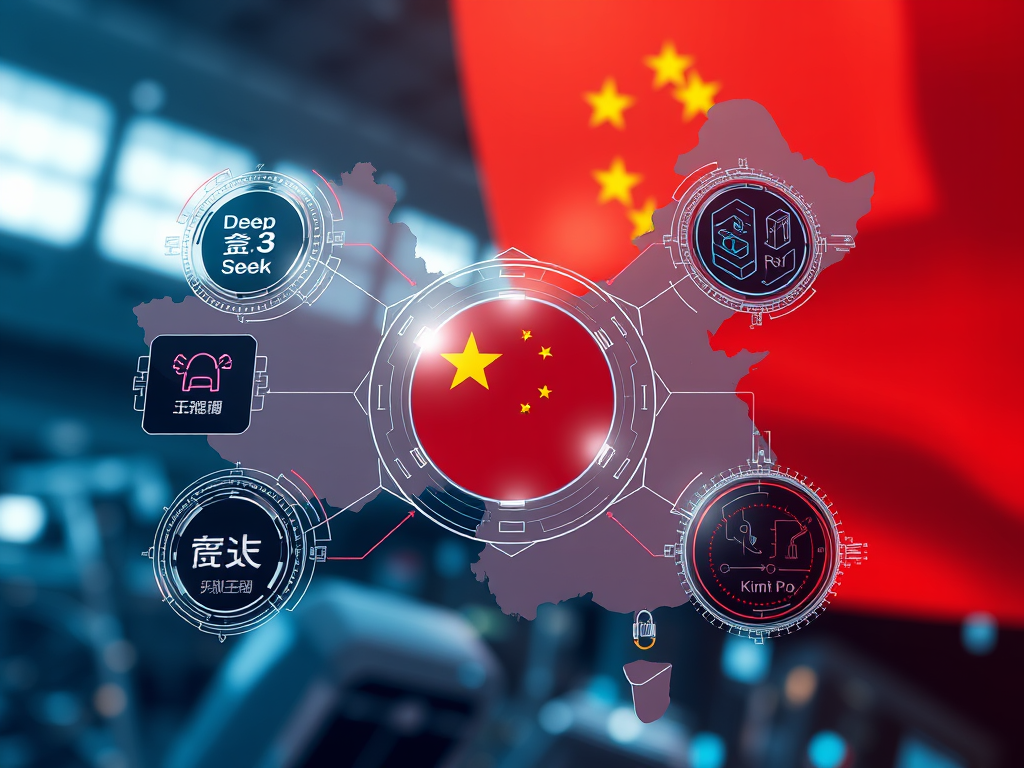The artificial intelligence landscape in China is characterized by rapid advancements and significant investments from major tech companies. Let’s explore the top AI models developed by Chinese companies, detailing their technical specifications, capabilities, and applications.
1. DeepSeek V3 and R1
- Model Type: Language Model
- Parameters:
- DeepSeek V3: 671 billion parameters
- DeepSeek R1: Also built on V3’s architecture with a similar parameter count, with distilled versions from 1.5 billion to 70 billion parameters
- Release Date: R1 in January 2025, V3 in December 2024
- Benchmarks:
- DeepSeek V3 achieved scores of 90.7% on CMath and 65.2% on HumanEval
- R1 excels in reasoning tasks with high accuracy in coding challenges
- License Type: Open source
DeepSeek employs a Mixture of Experts (MoE) architecture that allows only a subset of parameters to be activated at any time, optimizing computational efficiency. The model was trained using advanced techniques like reinforcement learning and supervised fine-tuning, enhancing its reasoning capabilities and output clarity. The innovative training process involves fine-tuning on a carefully curated dataset to improve performance across various tasks.
2. Alibaba Qwen 2.5-Max
- Model Type: Multimodal Language Model
- Parameters: Speculated to exceed 100 billion parameters
- Release Date: January 2025
- Benchmarks: Achieved a score of 89.4 on the Arena-Hard benchmark
- License Type: Open source
Qwen 2.5-Max is designed for enterprise applications and supports text, image, and audio processing. Its transformer-based architecture utilizes self-attention mechanisms for improved contextual understanding. The model is optimized for low-resource deployment, making it suitable for edge computing applications.
3. ByteDance Doubao-1.5-Pro
- Model Type: Language Model
- Parameters: Utilizes a sparse MoE architecture with fewer activation parameters for efficiency
- Release Date: January 2025
- Benchmarks: Surpasses industry standards in knowledge retention, coding proficiency, reasoning skills, and Chinese language processing
- License Type: Proprietary
Doubao-1.5-Pro is recognized for its cost-efficiency and performance improvements over previous models. It integrates visual understanding capabilities through the Doubao visual model and provides real-time voice interaction features, enhancing user experience in conversational AI applications.
4. Moonshot AI’s Kimi K1.5
- Model Type: Language and Multimodal Model
- Parameters: Not specified but designed to be competitive with leading models like OpenAI’s GPT series.
- Release Date: January 2025
- Benchmarks: Claims to outperform OpenAI’s models in mathematics and coding tasks; specific scores not disclosed.
- License Type: Open source
Kimi K1.5 leverages deep learning algorithms to analyze data efficiently and generate intelligent responses across various domains. It excels in both text comprehension and visual input processing, making it suitable for applications requiring multimodal interaction.
5. MiniMax Text-01
- Model Type: Language Model
- Parameters: Approximately 456 billion parameters with a context length of up to 4 million tokens
- Release Date: January 2025
- Benchmarks: Achieved high accuracy in standard evaluations; specific scores not disclosed.
- License Type: Open source
MiniMax employs a hybrid architecture combining “lightning attention” mechanisms with traditional transformer blocks to handle long contexts effectively. This design allows it to maintain performance while managing extensive data inputs, making it ideal for applications that require long-term memory capabilities.
6. iFlyTek Spark
- Model Type: Cognitive Model
- Parameters: Not specified but designed for extensive language understanding
- Release Date: June 2024
- Benchmarks: Competes favorably with global models; specific scores not disclosed.
- License Type: Proprietary
iFlyTek Spark is engineered for natural language processing tasks across various domains including technology and literature. It supports complex dialogue capabilities and can execute multifaceted tasks such as summarization and creative writing.
7. Baidu Ernie Bot 4.0
- Model Type: Language Model
- Parameters: Not publicly disclosed but known for large-scale training datasets
- Release Date: October 2023
- Benchmarks: Over 300 million users reported; performs well in conversational AI tasks; specific benchmark scores not disclosed.
- License Type: Proprietary
Ernie Bot was the first AI chatbot made publicly available in China and has been continuously updated to enhance its conversational abilities and knowledge retention features.
8. Tencent Hunyuan Aide
- Model Type: General-Purpose Language Model
- Parameters: Not specified but designed for broad applicability across different sectors
- Release Date: January 2025
- Benchmarks: Competes with other leading models; specific scores not disclosed
- License Type: Proprietary
Hunyuan Aide focuses on providing intelligent assistance across various applications including customer service automation and content generation.
9. Huawei Pangu Model
- Model Type: Large Language Model
- Parameters: Estimated at over 100 billion parameters
- Release Date: December 2024
- Benchmarks: High performance across multiple NLP tasks; specific benchmarks not disclosed
- License Type: Proprietary
The Pangu model is part of Huawei’s broader strategy to integrate AI into its cloud services, focusing on enterprise solutions that leverage natural language understanding.
10. SenseTime SenseChat
- Model Type: Conversational AI Model
- Parameters: Not specified but optimized for dialogue systems
- Release Date: 2024
- Benchmarks: Strong performance in dialogue coherence; specific scores not disclosed.
- License Type: Proprietary
SenseChat is tailored for customer service applications and aims to provide seamless interactions between users and automated systems through natural language understanding.
Conclusion
The rapid development of AI models by Chinese companies showcases their commitment to advancing technology in natural language processing, multimodal understanding, and cognitive capabilities. Each model presents unique features tailored to specific applications ranging from business solutions to consumer-facing products.
As these companies continue to innovate within the AI space, they are not only competing on a national level but are also positioning themselves as formidable players in the global market against established entities like OpenAI and Google DeepMind.
The ongoing advancements highlight the importance of collaboration between academia and industry to drive research forward while addressing ethical considerations related to AI deployment in society. With the increasing complexity of these models comes the need for responsible usage guidelines and regulatory frameworks that ensure their benefits are maximized while minimizing potential risks associated with their deployment in real-world scenarios.


Leave a Reply